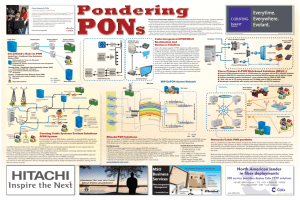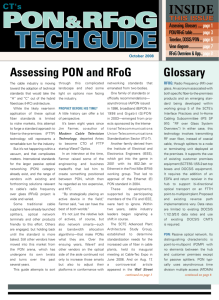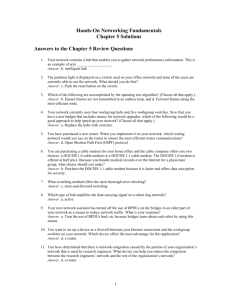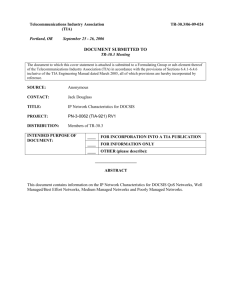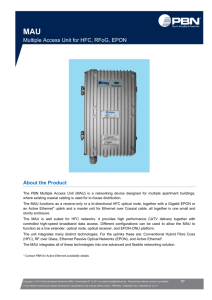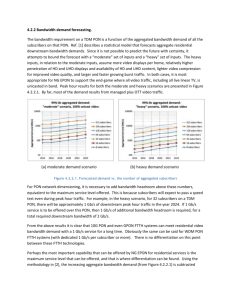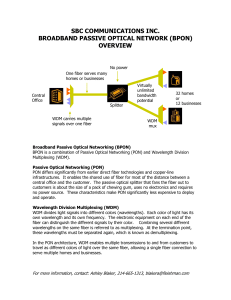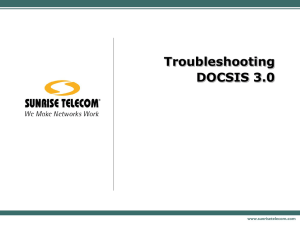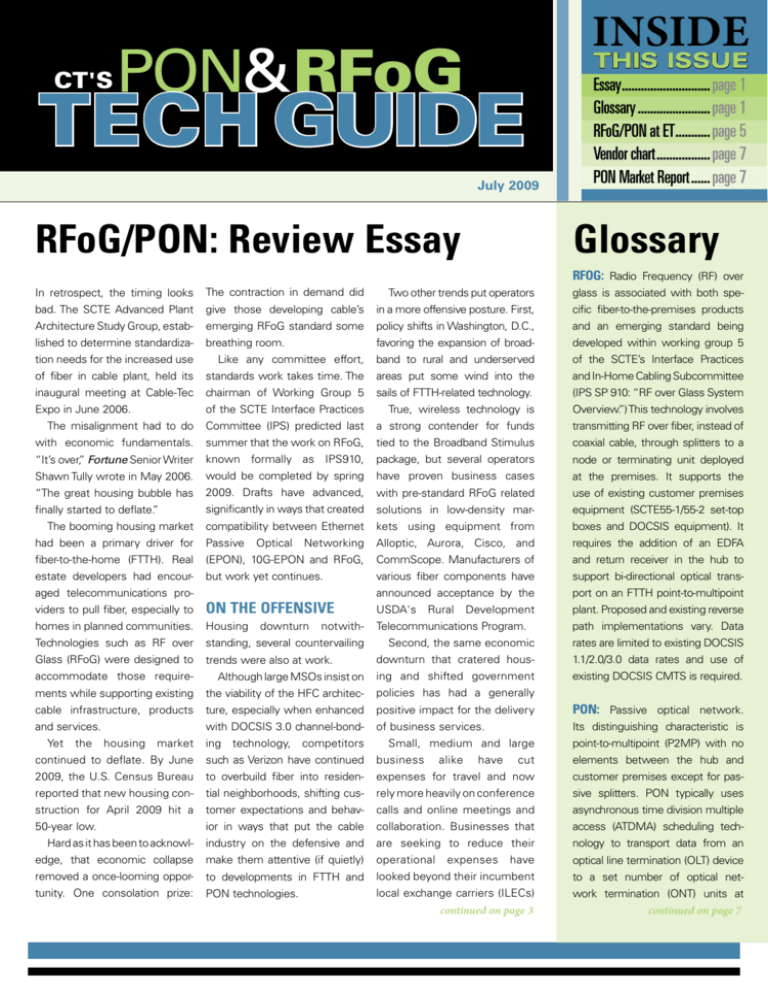
CT's
INSIDE
THIS issue
PON&RFoG
Tech Guide
July 2009
RFoG/PON: Review Essay
Essay............................. page 1
Glossary........................ page 1
RFoG/PON at ET............ page 5
Vendor chart.................. page 7
PON Market Report....... page 7
Glossary
RFOG: Radio Frequency (RF) over
In retrospect, the timing looks
The contraction in demand did
Two other trends put operators
glass is associated with both spe-
bad. The SCTE Advanced Plant
give those developing cable’s
in a more offensive posture. First,
cific fiber-to-the-premises products
Architecture Study Group, estab-
emerging RFoG standard some
policy shifts in Washington, D.C.,
and an emerging standard being
lished to determine standardiza-
breathing room.
favoring the expansion of broad-
developed within working group 5
tion needs for the increased use
Like any committee effort,
band to rural and underserved
of the SCTE’s Interface Practices
of fiber in cable plant, held its
standards work takes time. The
areas put some wind into the
and In-Home Cabling Subcommittee
inaugural meeting at Cable-Tec
chairman of Working Group 5
sails of FTTH-related technology.
(IPS SP 910: “RF over Glass System
Expo in June 2006.
of the SCTE Interface Practices
True, wireless technology is
Overview.”) This technology involves
The misalignment had to do
Committee (IPS) predicted last
a strong contender for funds
transmitting RF over fiber, instead of
with economic fundamentals.
summer that the work on RFoG,
tied to the Broadband Stimulus
coaxial cable, through splitters to a
“It’s over,” Fortune Senior Writer
known formally as IPS910,
package, but several operators
node or terminating unit deployed
Shawn Tully wrote in May 2006.
would be completed by spring
have proven business cases
at the premises. It supports the
“The great housing bubble has
2009. Drafts have advanced,
with pre-standard RFoG related
use of existing customer premises
finally started to deflate.”
significantly in ways that created
solutions in low-density mar-
equipment (SCTE55-1/55-2 set-top
compatibility between Ethernet
kets using equipment from
boxes and DOCSIS equipment). It
had been a primary driver for
Passive
Networking
Alloptic, Aurora, Cisco, and
requires the addition of an EDFA
fiber-to-the-home (FTTH). Real
(EPON), 10G-EPON and RFoG,
CommScope. Manufacturers of
and return receiver in the hub to
estate developers had encour-
but work yet continues.
various fiber components have
support bi-directional optical trans-
announced acceptance by the
port on an FTTH point-to-multipoint
USDA's
plant. Proposed and existing reverse
The booming housing market
aged telecommunications pro-
Optical
viders to pull fiber, especially to
On the offensive
homes in planned communities.
Housing
Technologies such as RF over
standing, several countervailing
Glass (RFoG) were designed to
trends were also at work.
downturn
notwith-
Rural
Development
Telecommunications Program.
path implementations vary. Data
Second, the same economic
rates are limited to existing DOCSIS
downturn that cratered hous-
1.1/2.0/3.0 data rates and use of
accommodate those require-
Although large MSOs insist on
ing and shifted government
existing DOCSIS CMTS is required.
ments while supporting existing
the viability of the HFC architec-
policies has had a generally
cable infrastructure, products
ture, especially when enhanced
positive impact for the delivery
PON: Passive optical network.
and services.
with DOCSIS 3.0 channel-bond-
of business services.
Its distinguishing characteristic is
Yet
the
housing
Small, medium and large
market
ing technology, competitors
continued to deflate. By June
such as Verizon have continued
business
cut
elements between the hub and
2009, the U.S. Census Bureau
to overbuild fiber into residen-
expenses for travel and now
customer premises except for pas-
reported that new housing con-
tial neighborhoods, shifting cus-
rely more heavily on conference
sive splitters. PON typically uses
struction for April 2009 hit a
tomer expectations and behav-
calls and online meetings and
asynchronous time division multiple
50-year low.
ior in ways that put the cable
collaboration. Businesses that
access (ATDMA) scheduling tech-
Hard as it has been to acknowl-
industry on the defensive and
are seeking to reduce their
nology to transport data from an
edge, that economic collapse
make them attentive (if quietly)
operational
have
optical line termination (OLT) device
removed a once-looming oppor-
to developments in FTTH and
looked beyond their incumbent
to a set number of optical net-
tunity. One consolation prize:
PON technologies.
local exchange carriers (ILECs)
work termination (ONT) units at
continued on page 3
continued on page 7
alike
have
expenses
point-to-multipoint (P2MP) with no
Cisco Prisma D-PON
Your DOCSIS-Based Fiber-to-the-Home PON Solution
Meeting and Beating the Bandwidth Crunch
The Cisco® Prisma D-PON products offer you an industry-leading FTTH solution
specifically for DOCSIS-based service providers. The D-PON solution can provide
you with:
• Low-cost solution for master planned community (MPC) and greenfield growth
• Robust bandwidth – capable of supporting multiple DOCSIS devices and DOCSIS
3.0 channel bonding in the upstream through a 28dB link budget
• Future-flexible network – creating a low cost future upgrade path
• The advantage of leveraging existing back office infrastructure
• Industry-leading performance... it’s RFoG+
The Cisco D-PON solution enables DOCSIS 3.0 channel bonding for more
available bandwidth in the network, support of more bandwidth-intensive services
and increased data speed rates, fulfilling the consumer appetite for advanced
feature-rich entertainment and communications.
Learn more at www.cisco.com/go/dpon
RFoG/PON Review
continued from page 1
for better services and pricing.
of FTTP operations will look
DOCSIS Mediation Layer (DML)
The cable industry has been
increasingly like those they’ve
technology. In effect a middle-
The initial 10G-EPON standard
the beneficiary of much if not all
faced before with DOCSIS.
ware, it enables system vendors
will support a 10 Gbps down-
of that growth. Years of work in
This is the challenge of quickly
to run DOCSIS OSSI service
stream channel, 1 Gbps down-
the business services market—
deploying, provisioning and
interfaces,
and
stream channel (to be compatible
more than a decade for Cox
supporting services. Thus, the
PacketCable Multimedia on exist-
with existing EPON in place), and
Communications—has intensi-
still-emerging DOCSIS over
ing GigEPON and future, forth-
a shared 1 Gbps upstream chan-
fied across the board for opera-
EPON market.
coming 10G-EPON systems.
nel for both existing 1GigEPON
PacketCable
should follow.
tors and vendors alike. Several
In CT’s first RFoG/PON tech
This development at the chip
ONUs and new 10/1GigEPON
indicators would be the distance
guide, published last October,
level is likely to drive the pro-
ONUs. The 10Gbps capability
learning, telehealth and telep-
there was a single entry in
duction of additional products
opens the door for even more
resence exhibits seen in various
this
Hitachi
based on the same technol-
substantial and larger business.
venues at The Cable Show in
Communications’ Salira Systems
ogy, as it facilitates the entry
The standard also positions
April this year.
group. In April this year, two
of any systems vendor into the
10G-EPON as the most suitable
category
from
So while FTTH has been
months after Motorola became
MSO market. Dozens of ven-
and scalable access technol-
put on the back burner, fiber
the exclusive distributor for
dors already are supplying tens
ogy for 4G cell tower backhaul
to the premises (FTTP)—or to
its RFoG products, Alloptic
of millions of ports in Japan,
services. EPON is already in
outposts of business prem-
announced the availability of its
Korea, and now China. (See
use for 2.5G and 3G cell tower
ises, even competitive ones,
DOCSIS PON Controller (DPC)
sidebar, page 7.)
backhaul in the United States
and abroad. With the shift to
“Several operators have proven business
cases with pre-standard RFoG... in
low-density markets.”
4G and focus on mobile broadband, the demand for backhaul
will push beyond the singledigit Gbps barriers of EPON,
GPON, and SONET.
Which technology will be
able to support the need for
hundreds of Mbps for multiple
sites on a single strand of glass?
such as cell towers—is grow-
software, designed to enable
At least some of the largest
ing significantly. As it happens,
DOCSIS provisioning and control
suppliers are likely to develop
it was in business services
of its EPON system.
those some products, with some
As mentioned, SCTE’s IPS
software accommodations, for
WG 5 continues its work on
the U.S. MSO market.
RFoG. The sustained appeal of
Possibly the only candidate for
that role is 10G-EPON.
that EPON first emerged as
In May, two months after
a solution in cable. For servic-
entering the RFoG market with
es beyond the capabilities of
its FTTMax 1000 optical network
DOCSIS 3.0 and RFoG, MSOs
unit (ONU), ARRIS launched an
Standards: IEEE, SCTE
are now looking to EPON as
EPON optical line terminal (OLT)
Meanwhile, the 10G-EPON stan-
by operating gateways at both
a way to serve those same
and EPON ONU as extensions
dard, IEEE P802.3av, is progress-
the hub and customer prem-
business customers.
to its CHP Max 5000 chassis.
ing as expected. The task force
ises site that would support
DOCSIS over EPON
Adding validity—and generat-
should complete its work early
existing forward and reverse
ing buzz at The Cable Show—was
this fall. Once the standard is
optical systems at the hub
As MSOs scale their busi-
an announcement at the event
approved, product announce-
site and coaxial-based devices,
ness services, the challenges
by chipset vendor Teknovus of a
ments and products themselves
including both unidirectional
editorial
editor Jonathan Tombes
(301) 354-1795, jtombes@accessintel.com
managing editor Ron Hendrickson
(303) 422-3373, rhendrickson@accessintel.com
contributing analyst Victor Blake
RFoG is the proposed capability to support FTTP or FTTH
design/production
senior art director Tzaddi Andoque (301) 354-1677
senior production manager John Blaylock-Cooke
(212) 621-4655
Access Intelligence
4 Choke Cherry Road, 2nd Floor, Rockville, Maryland 20850
3
and bidirectional set-top boxes
In a rural development with,
multi-access optical network.
the probability of a collision
and DOCSIS devices, at the
for example, a dozen or so
Unlike PONs, most RFoG tech-
(not in RF but) in the optical
customer premises.
homes in a 20 km span, RFoG
nology (including the proposed
domain is significantly higher.
could offer both a lower cost and,
RFoG standards) does not use
If that were not enough, the
with DOCSIS, more than enough
a scheduler.
variations in DOCSIS 3.0 con-
RFoG applications
In the potential greenfield mar-
bandwidth for 12 subscribers.
To keep costs down, most
figurations make it ever more
ket, RFoG is appealing because
Yet a combination of challeng-
RFoG systems on the mar-
of its light touch: In theory,
es continues to add on the com-
ket simply turn on (burst) an
Take DOCSIS 3.0 upstream
nothing in the system would
plexity to RFoG. Operators have
upstream laser whenever they
channel configurations, which
need to be changed except for
been surprised to find some
sense the beginning of an
allow for 3.2 MHz, 6.4 MHz,
the construction to the premis-
RFoG systems are only compat-
upstream DOCSIS or DAVIC
or 12.8 MHz wide channels
es. As discussed at the outset,
ible with DSG and DOCSIS and
transmission. These systems
in any variation adding up to a
however, greenfields have all
not DAVIC. Other RFoG systems
rely on the low data rates of
minimum of 12.8 MHz of com-
but dried up.
support DAVIC and DOCSIS 1.0,
DAVIC and DOCSIS and count
bined upstream channel band-
1.1, and 2.0, but do not support
on a statistically low chance
width. Vendors and operators
DOCSIS 3.0.
(improbability) of the simulta-
developing
neous transmission (collision)
must struggle with the bal-
of two devices.
ance between keeping RFoG
While that has left RFoG
without its largest expected
is
While economically proven
potentially useful for opera-
in certain cases, a solution with
tors that might want to offer
FTTH using RFoG does requires
In DOCSIS, this is a reason-
video services to fiber-based
expense, yet with no increase
able assumption because the
Ethernet customers. When the
in available bandwidth. Limiting
DOCSIS system itself manag-
market,
the
technology
challenging.
the
technology
cost low and the need for
forward compatibility.
An RFoG product not com-
bandwidth demands justify it,
DOCSIS over EPON is likely
to supplant RFoG as the FTTH
strategy of choice.
Yet RFoG will continue to be
useful for operators for as long
as there is an inventory of nonDOCSIS (DAVIC)-based set-top
boxes. With inventories in the
tens of millions, many of which
are new HD and HD-DVR systems, the technology will have
“When that transition (to IP) occurs is a
big question. One near-term appeal of
RFoG is its link to the installed base of
millions of non-DOCSIS set-tops.”
some shelf life.
An equally important application of RFoG is the use of
the future potential of such
es each of the clients to avoid
patible
FTTH in more rural develop-
a network by not supporting
a simultaneous transmission.
defeats one of the principal
ments. (See above.) As homes-
DOCSIS 3.0 is a difficult strat-
In the case of an actual colli-
goals of the initiative. If these
passed density drops, the cost
egy to support.
DOCSIS
3.0
sion, all of the data protocols
challenges can’t be met cost
of traditional HFC plant rises,
DOCSIS 3.0 having arrived,
allow for network level retrans-
effectively, RFoG may be rel-
as the number of amplifiers
some RFoG solutions are now
mission. DOCSIS 3.0 channel
egated to “video duty” for
and length of coax copper plant
outdated. Solutions being explored
bonding allows for the inde-
EPON and long-reach low-den-
rises. With the rising price of
could potentially support DOCSIS
pendent and possible simulta-
sity rural applications.
copper and falling fiber costs,
3.0, but with added cost.
neous transmission of multiple
most new rural development is
4
with
more cost-effective with fiber.
DOCSIS dilemma
Once the cost of active plant
upstream channels.
Conclusion
DOCSIS 3.0 is different
Long-term, DOCSIS over EPON
PONs typically employ some
from DOCSIS 1.1 and 2.0 in
appears to have cost-structure
powering and supporting oper-
type of scheduler to manage
that clients in a (shared) serv-
advantages. Even today, an
ational costs are considered,
the transmission and recep-
ing group can transmit at the
EPON ONU costs less than
passive fiber solutions become
tion from multiple transmitters
same time (albeit on differ-
an RFoG gateway (or R-ONU).
even more attractive.
and receivers on a shared or
ent channels). As a result,
continued on page 7
RFoG and PON at ET
Fiber continues to be a news
Management of Ethernet PON
layer to translate DOCSIS man-
RFoG
item. Passive optical network-
Infrastructure," and Oleh Sniezko,
agement into language the fiber
Sniezko's paper treats RFoG as
ing (PON) in particular is hot. A
CTO of Aurora Networks, present-
network can understand, thus
a hedge against competition. It's
late May report by the Dell'Oro
ed "RFoG—How to Make It Work
preserving the cable operator's
essentially transitional technol-
Group indicates that worldwide
and How to Expand It." Both deal
DOCSIS
ogy designed to facilitate moving
PON equipment revenues grew
with evolutionary approaches to
expanding bandwidth.
9 percent sequentially in the first
fiber, working with existing cable
Chen writes that DEPON can
same RF signals appearing at
quarter of this year. (For more,
infrastructure rather than doing
scale up available bandwidth
customer outlets as in HFC net-
see sidebar, page 7.)
a prohibitively expensive whole-
beyond the capabilities of current
works. RF signals are carried via
sale rip-and-replace.
DOCSIS 3.0 implementations
fiber to the premises, where they
and is cost effective. He also
transition to coax.
RF over Glass (RFoG) also
generated news, with several
investments
while
from HFC to FTTH, with the
vendors announcing products
DEPON
argues that the same concepts
Sniezko describes RFoG's
designed to support it. (For more
Chen's
a
can be extended to include simi-
current status, compares it
on RFoG vendors, see page 6.)
paper
advocates
DOCSIS over EPON (DEPON)
lar functionality for PacketCable
with HFC, analyzes ways to
Despite all that, there was
architecture designed to enable
1.5, PacketCable 2.0, PacketCable
make RFoG more appealing
relatively little emphasis on fiber
EPON fiber access networks
Multimedia, L2VPN, Business
to cable operators, and pres-
optics at the SCTE's Conference
to be managed by existing
Services over DOCSIS (BSoD),
ents some technical and archi-
on Emerging Technologies this
DOCSIS infrastructure and oper-
DOCSIS Set-top Gateway (DSG),
tectural solutions intended to
year. James Chen, CTO of Salira
ations support systems (OSSs).
and other operations built on the
improve RFoG’s performance
Systems, presented "DOCSIS
DEPON provides a middleware
DOCSIS foundation.
and ease of operation.
the FTTH solution
that fits perfectly
with existing HFC
Network
Interface
Device
(NID)
Back-Up
Power Supply
Network Interface
Unit (NIU)
Optical
Tap
Fiber Drop
Armored
Cable
Fiber Flat
Drop Cable
in Conduit
FTTH made simple!
TM
BrightPath is a simple approach to FTTH, employing reliable technology and
standard cable installation practices to allow cable operators to deploy FTTH in
new build areas without altering existing infrastructure.
®
- This cost effective RFoG system can be installed as needed within an HFC network
- The total system cost is highly competitive with advanced HFC systems,
especially in low density and rural areas
- Another innovation from a business partner
you already trust
©2009, CommScope, Inc. All Rights Reserved.
AB
®
800.982.1708
5
SubScribe for free to
Communications Technology is
a global resource that provides
broadband engineers, executives and
managers with reliable information
on technology trends, strategy,
implementation and best practices.
Sign up for a free SubScription
today by viSiting
www.omeda.com/ct
introducing
digital delivery of
Communications Technology is now available digitally!
Enjoy the ease and convenience of receiving and reading
each issue on your computer. The digital version delivers
the same look and feel of the print magazine and includes
all of the same information. In addition, you’ll enjoy the
following benefits:
❖ No software needed
❖ Clickable table of contents
❖ Easy keyword search
❖ Clickable links to advertisers
❖ Best of all, it’s FREE!
GO DIGITAL! Eliminate clutter in your mailbox and enjoy the interactive capabilities
only available online. You can even download each issue to your laptop!
to SubScribe for free, Simply viSit
www.omeda.com/ct
15161
Vendor Name
RFoG Only
EPON
DPON
(DOCSIS +
EPON) + RFoG
EPON
Aurora Networks
Cisco Systems
Commscope
RFoG
DPON
x
x
x
Report: PON Market Shines
The Dell'Oro Group's "Access Quarterly
Report" issued in May 2009 indicates
that worldwide PON equipment rev-
ECI Telecom
Huawei
ZTE
Pacific Broadband
Networks
Enablence
x
x
x
x
x
x
x
Hitachi Telecomm (Salira
Systems)
Arris Corporation
Alloptic Networks
x
x
x
x
x
x
enues grew 9 percent sequentially in
the first quarter of this year, despite a
weak global economy. The report indicates that both GPON and EPON had
robust sequential growth.
x
x
x
In a statement, Tam Dell'Oro, president of the Dell'Oro Group, said, "PON
revenue growth in the first quarter was
higher than what we had expected due
Note:
This list does not include EPON vendors that do not offer products for sale in the US. There are a
number of vendors that sell EPON products in Japan that do not offer them for sale in the US and do
not want to sell or support those products in the US.
to rapidly increasing EPON buildouts in
China, strong GPON ONT shipments
for Verizon's FiOS service, and continued strong EPON demand in Japan."
The report says that Mitsubishi
remained the leader in the overall
continued from page 4
PON market, benefiting significantly
With multiple suppliers and now off-the-
millions of non-DOCSIS set-tops. Or, at
from being the primary EPON sup-
shelf chipset and middleware solutions,
least, all RFoG products should be able to
plier to NTT, Japan's largest service
the economics of DOCSIS over EPON as
serve the base, as that is a major point the
provider. Alcatel-Lucent recaptured
a solution for 1Gbps now and 10Gbps later
of initiative.
the No. 2 position with higher GPON
looks even better.
Perhaps the most significant develop-
ONT shipments to Verizon. Huawei's
The key for DOCSIS over EPON suc-
ment during the last year has been the
revenue share nearly doubled from
cess will be a transition to DOCSIS based
effort to create compatibility for both
last quarter, and the company vaulted
set top boxes (Docsis Set-top Gateway) or
EPON and RFoG. Neither standards is yet
to the No.3 spot because of strong
ultimately a transition to IP-based video
complete, current drafts would allow for
EPON shipments to China, as well as
distribution. When that transition occurs
the operation of both in parallel on the
higher GPON shipments to custom-
is big question. One near-term appeal of
same fiber serving the same or different
ers in Europe and the Middle East.
RFoG is its link to the installed base of
customers.
Glossary
continued from page 1
the premises. Upstream signals
at 2.488 Gbps downstream and
(sometimes called GE-PON) to
ages a cable operator’s DOCSIS
are combined using a multiple
1.244 Gbps upstream. Verizon
support 1 Gbps symmetrical,
networks and operational sup-
access protocol. It is contrasted
began deploying GPON in late
with dual-speed EPONs capable
port systems (OSSs). While
with more capital-intensive point-
2007 and standardized on GPON
of 2.5 Gbps/1 Gbps. The IEEE
RFoG relies on a CMTS and RF
to-point (P2P) architectures.
for all new deployments in early
10 Gbps EPON study group
transport (over optical), DPON
2008. ITU-T SG15 (Study Group
(P802.3av) is completing work
moves the compatibility back
GPON: Gigabit PON (ITU-T 15) has adopted IEEE 10GigEPON on the first 10G/1G standard, to the OSS interfaces, making
G.984); the successor to BPON.
(P802.3av) as the foundation for
with chipsets expected in 2009.
an EPON OLT look and act like
It provides for transport of asyn-
Next Generation (NG) PON.
A number of cable operators
a CMTS. While eliminating the
already have deployed EPON to
need for the DOCSIS CMTS, it
chronous transfer mode (ATM),
time division multiplexing (TDM)
EPON: Ethernet PON (IEEE serve business customers.
offers compatibility for provision-
and Ethernet, but has shifted
802.3ah). EPON initially support-
ing and operations. Unlike RFoG,
over several years to primarily
ed 100 Mbps symmetric and
DPON OR DEPON: DOCIS over it will support EPON data rates
an Ethernet standard, operating
has evolved as Gigabit Ethernet
EPON. A combination that lever-
up to 10Gbps/1Gbps.
7
Convergence Enabled.
MISSION: To maintain an operationally efficient and cost effective infrastructure when adding new voice, video and
data services, and expanding the existing subscriber base.
SOLUTION: ARRIS network technologies and product platforms for all architectures, including
Supported architectures:
•
•
•
•
Hybrid Fiber Coax
Fiber to the premise
Extended Reach
Fiber Deep (Node + x)
Leading technologies:
•
•
•
CORWave and CORWave II multi wavelength plans for more services over as few as one fiber
RFoG and EPON solutions that co-exist over the same fiber
Variable output transmitters that allow output powers to be configured by the customer rather
than pre-ordered from the factory
Product platforms:
•
•
•
•
•
CHP Max headend optics - Indoor optical/RF conversion platform and components
Opti Max nodes - Outdoor optical/RF conversion platform and components
Flex Max Amplifiers - Outdoor RF amplification
FTTMax – Fiber to the premise RFoG and EPON platforms
Trans Max- Outdoor Optical long haul transmission platform and components
With over 50 years of commitment to the cable industry, ARRIS is a trusted partner and solution provider to
cable operators worldwide.
www.arrisi.com
Expect More from Your Network.

